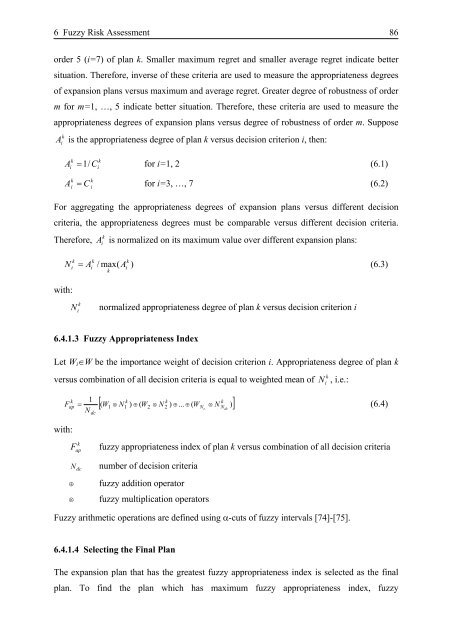Transmission Expansion Planning in Deregulated Power ... - tuprints
Transmission Expansion Planning in Deregulated Power ... - tuprints
Transmission Expansion Planning in Deregulated Power ... - tuprints
Create successful ePaper yourself
Turn your PDF publications into a flip-book with our unique Google optimized e-Paper software.
6 Fuzzy Risk Assessment 86<br />
order 5 (i=7) of plan k. Smaller maximum regret and smaller average regret <strong>in</strong>dicate better<br />
situation. Therefore, <strong>in</strong>verse of these criteria are used to measure the appropriateness degrees<br />
of expansion plans versus maximum and average regret. Greater degree of robustness of order<br />
m for m=1, …, 5 <strong>in</strong>dicate better situation. Therefore, these criteria are used to measure the<br />
appropriateness degrees of expansion plans versus degree of robustness of order m. Suppose<br />
k<br />
A i is the appropriateness degree of plan k versus decision criterion i, then:<br />
A = 1/<br />
C<br />
for i=1, 2 (6.1)<br />
k<br />
i<br />
k<br />
i<br />
k<br />
i<br />
k<br />
i<br />
C A = for i=3, …, 7 (6.2)<br />
For aggregat<strong>in</strong>g the appropriateness degrees of expansion plans versus different decision<br />
criteria, the appropriateness degrees must be comparable versus different decision criteria.<br />
Therefore,<br />
k<br />
A i is normalized on its maximum value over different expansion plans:<br />
k k<br />
k<br />
N = A / max(<br />
A )<br />
(6.3)<br />
i<br />
with:<br />
i<br />
k<br />
i<br />
k<br />
N i normalized appropriateness degree of plan k versus decision criterion i<br />
6.4.1.3 Fuzzy Appropriateness Index<br />
Let Wi∈W be the importance weight of decision criterion i. Appropriateness degree of plan k<br />
versus comb<strong>in</strong>ation of all decision criteria is equal to weighted mean of<br />
k<br />
k<br />
k<br />
[ ( ) ( ) ... ( ) ] N W<br />
N W N W ⊗ ⊕ ⊗ ⊕ ⊕<br />
k 1<br />
F 1 1 2 2<br />
N ⊗<br />
c<br />
N<br />
with:<br />
ap Ndc<br />
dc<br />
k<br />
N i , i.e.:<br />
= (6.4)<br />
k<br />
F ap fuzzy appropriateness <strong>in</strong>dex of plan k versus comb<strong>in</strong>ation of all decision criteria<br />
N dc number of decision criteria<br />
⊕ fuzzy addition operator<br />
⊗ fuzzy multiplication operators<br />
Fuzzy arithmetic operations are def<strong>in</strong>ed us<strong>in</strong>g α-cuts of fuzzy <strong>in</strong>tervals [74]-[75].<br />
6.4.1.4 Select<strong>in</strong>g the F<strong>in</strong>al Plan<br />
The expansion plan that has the greatest fuzzy appropriateness <strong>in</strong>dex is selected as the f<strong>in</strong>al<br />
plan. To f<strong>in</strong>d the plan which has maximum fuzzy appropriateness <strong>in</strong>dex, fuzzy

















